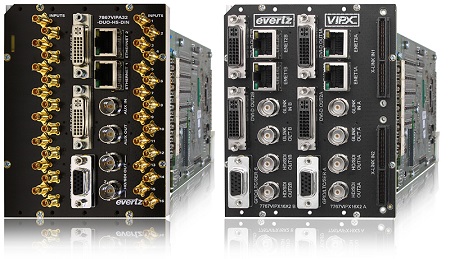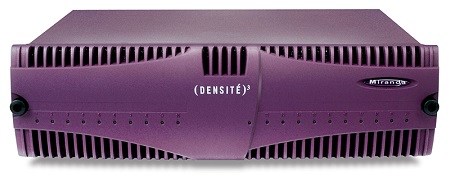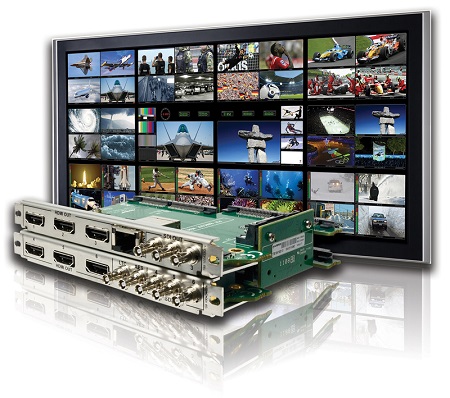Manufacturers Take Pragmatic Approach to 4K Multiviewers
MULTIPLE CITIES—4K/ultra HD is a broadcast/production technology that has generated a lot of discussion and interest, and is seeing increasing use in cinema and television production. It is only a matter of time before the new format is universally adopted—the point on which people have yet to agree is precisely when.
For broadcast equipment manufacturers, this vagueness poses a dilemma: If they move into providing 4K technology too aggressively, they risk ending up with bleeding-edge equipment that sits in their warehouses because nobody other than a handful of early adopters is willing to buy it. On the other hand, if these same manufacturers sit back and let their competitors lead on 4K, they risk missing out on the market entirely.
Faced with this "damned if you do/damned if you don't" dilemma, most multiviewer manufacturers are taking a measured approach to 4K capability, by including some degree of it in their existing HD products. That said, one company—Blackmagic Design—has decided to claim the bleeding edge by offering a native 4K multiviewer to the world market.
BLACKMAGIC DESIGN'S 4K GAMBLE
Introduced at IBC 2014 in September 2014, Blackmagic's MultiView 16 multiviewer is being billed as "the world's first native ultra HD multiviewer." The reason: The MultiView 16 can actually feed consumer-grade 4K UHD monitors using single HDMI connections. For broadcasters/producers who prefer to use professional-grade 4K monitors, the MultiView 16 can feed them using pairs of 6G-SDI inputs.

Blackmagic MultiView 16 Each 6G-SDI input comes with automatic frame re-synchronization, allowing each video window to be configured as an independent video monitor. This allows the operator to display up to 16 windows, each one set to their own video standard.
"The MultiView 16 makes it possible for operators to get into 4K monitoring economically, by connecting to affordable consumer-grade 4K monitors today," said Dan May, president of Blackmagic Design. "At the same time, the system can also support professional-grade 4K monitors, using pairs of 6G-SDI cables."
Blackmagic MultiView 16 Specs
Get the TV Tech Newsletter
The professional video industry's #1 source for news, trends and product and tech information. Sign up below.
Billed as the world's first native 4K/UHD multiviewer, the Blackmagic MultiView 16 can connect to a consumer grade 4K monitor using a single HDMI cable, or to a professional-grade 4K monitor using two of the unit's 6G-SDI outputs.
The nitty-gritty
• Installed in a small 1RU chassis for rack-mounting.
• Can show up to eight UHD or up to 16 SD-/HD-SDI sources on a single HD or ultra HD. display via SDI or HDMI. Mixing of SD, HD and UHD sources/outputs supported.
• Comes equipped with 16 multirate 6G-SDI inputs with loop thru, compatible with all SD, HD and ultra HD equipment.
• Each 6G-SDI channel comes with automatic frame re-synchronization. This allows the MultiView 16 to handle simultaneous display of mixed SD, HD and UHD formats.
• Users can choose from solo, 2x2, 3x3 or 4x4 grid views.
• Supported output resolutions: 1,920x1,080 and 3,840x2,160 pixels.
• Equipped with front panel controls: Dedicated source buttons, LCD screen and spin-knob control.
• Built in 90-240V AC international power supply; global use.
• Remote control via Ethernet using the included Mac and Windows software, or using Blackmagic Videohub hardware control panels.
All of the MultiView's 16 inputs are based on the 6G-SDI standard, with the ability to display SD, HD and (when paired) 4K/UHD video sources.
"All 16 inputs feature automatic frame re-synchronization," May said. "This allows each video to be akin to an independent video monitor, regardless of the input standard. As a result, customers can mix and match up to 16 different video standards on the same multiviewer."
The input sources can come from cameras, video servers, switchers, routers, external feeds or any other standard HD/4K source. (There are no universal distribution standards yet for 4K/UHD, so do your research before assuming that the device you have will act as a "standard 4K source."
The Blackmagic MultiView 16 can support up to 16 outputs in both 1080p HD and native 4K/UHD, to both SDI and HDMI monitors. Available multi-window layouts are 2 x 2 for four sources, 3x3 for nine sources and 4x4 for 16 sources. Using a 4K display, the MultiView 16 can offer four full resolution 1,920 x 1,080-pixel HD video windows when in a 2x2 layout, or 16 half-resolution 1080 HD windows at 960 x 540-pixel resolution in 4x4.
The 1RU unit can be controlled directly using its front panel controls with dedicated source buttons, LCD screen and spin knob. It can also be controlled remotely by Ethernet using included Mac and Windows software, or Blackmagic's Videohub hardware control panels.
MANUFACTURERS HEDGE THEIR BETS
It is the Blackmagic MultiView 16's ability to feed a consumer-grade 4K monitor with a single HDMI cable that ultimately justifies its claim to be a native 4K multiviewer. As for multiviewers made by Evertz, Grass Valley and Imagine Communications (formerly Harris Broadcast), they too can support 4K displays, but they do so by adapting their existing HDTV technology.
"Our VIP series of multiviewers support 4K monitors by combining four HD-SDI inputs to acquire a single 4K video source, and then outputs 1080p," said Ketan Petal, Evertz's multiviewer product manager. This provides Evertz's customers with the 4K capability they are looking for, on a pragmatic 1080p-centric platform.

Evertz VIPA-VIPX A similar four-into-one approach is used by Grass Valley's Kaleido family of multiviewers. (The Kaleido line became a Grass Valley product when the company merged with Miranda Technologies earlier this year.)
"Using either four HD-SDI inputs or outputs, we can service 4K sources and 4K monitors," said Boromy Ung, Grass Valley's vice president of monitoring and control. "This allows our customers to move up into 4K when they wish, while using products that address their current 1080p needs."
Imagine Communications' Platinum family of multiviewers also uses the four-in-one approach. "However, we offer two ways of doing this," said Robert Millis, the company's senior product manager of measurement and monitoring products. "The first option is to feed a 4K professional grade monitor using four HD-SDI outputs. The second is to connect to a consumer-grade 4K monitor using four HDMI cables."

Grass Valley Kaleido Modular X In taking this pragmatic approach to 4K, these manufacturers are trying to balance serving potential customer demand with the chances that 4K may prove to be as ephemeral as 3DTV proved to be.
"There is currently not a lot of demand for 4K products," said Ketan Patel.
Imagine's Millis agreed, saying, "Most customers are quite satisfied with the resolution provided by 1080p multiviewers."
"The lack of a 4K broadcast production standard is a real issue," Ung said. "As a manufacturer, we do not want to commit to a format that our customers may not buy once a 4K standard comes into being."

Imagine Communications Platinum SXProTHE MESSAGE TO BROADCASTERS
The multiviewer manufacturers' reserve about 4K products is sending a message that broadcasters and producers need to heed. "Yes, the technology does work and can be supported," the message says. "But there is no rush to adopt 4K right now, and there is still enough doubt about 4K's chances that restraint is advised."
The good news is that these multiviewer manufacturers are making it possible for their customers to hedge their own 4K bets, thanks to the 4K capability built into their systems.
For Blackmagic Design, this hedge is found in the MultiView 16's SD/HD/UHD compatibility—and low $1,495 price tag. For Evertz, Grass Valley and Imagine Communications, the hedge is their decision to make their 1080p multiviewers support 4K when necessary, rather than the other way around.
For broadcasters and producers, the manufacturers' implicit message of "flexible restraint" is one worth heeding. Thanks to the Blackmagic Design's MultiView 16, it is now possible to become familiar with 4K on a very affordable basis, both due to this unit's low price tag and ability to work with 4K consumer monitors. Meanwhile, other multiviewers also allow broadcasters and producers to start experimenting with 4K, without making major equipment upgrades and purchases.
The flip side of the multiviewer question is the display on which the image is shown. Large, good-quality consumer-grade displays have been available for a year or more, with prices steadily falling. Name-brand manufacturers are now turning out 4K displays in a variety of sizes, including up to 80-inch diagonal sets, at prices that are not much higher than HD sets with similar features.
If you're squeamish about investing in consumer-grade 4K displays for a monitor wall that will be on 24/7, commercial products are available from manufacturers such as Planar, TVLogic, Panasonic, Sony, JVC and others.
As with HD multiviewers, the likely first-adopters in the professional video industry will be remote production trucks that are rented out for big sports and other major events. As more 4K cameras are used in such production, those trucks will need 4K displays—and function of 4K multiviewers is a given at that point.
Whether the industry is ready to make the leap to 4K/UHD so soon after adopting HD remains to be seen. However, with prices of 4K products dropping to the point where it is only a marginal difference in cost between 4K and HD, it seems likely that 4K will have a future in professional facilities.
James Careless is an award-winning journalist who has written for TV Technology since the 1990s. He has covered HDTV from the days of the six competing HDTV formats that led to the 1993 Grand Alliance, and onwards through ATSC 3.0 and OTT. He also writes for Radio World, along with other publications in aerospace, defense, public safety, streaming media, plus the amusement park industry for something different.

